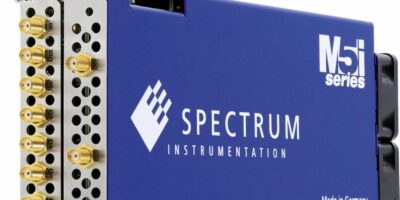Digitiser cards accelerate for real time processing speeds
Two PCIe digitiser cards from Spectrum Instrumentation are based on 16-lane, Gen 3, PCIe technology and are capable of streaming acquired data over the bus at 12.8Gbytes per second. That is nearly twice as fast as any other PCIe digitiser currently on the market, said the company. The data rate also allows the cards to continuously run at their maximum sampling rate of 6.4Gsamples per second with 12-bit resolution and transfer the acquired data directly to PC memory for storage or to CPUs and CUDA-based GPUs for processing and analysis.
The M5i.3330-x16 is a single channel card that can sample at rates up to 6.4Gsamples per second and the M5i.3337-x16 (pictured) is a dual channel card that offers synchronous 3.2Gsamples per second sampling on both channels, or the full 6.4Gsamples per second on a single channel. The digitisers have 12-bit resolution and dynamic range that is up to 16 times better than most digital oscilloscopes or comparable 8-bit digitisers, claimed Spectrum. The extra resolution improves voltage measurement precision and allows users to capture and characterise fine signal details that are often missed by lower resolution devices. A PLL-based internal clock ensures timing measurements with better than one part per million accuracy.
The cards operate over a 2GHz bandwidth and are programmable with full-scale ranges from ±200mV to ±2.5V and variable offset. For the capture of long and complex waveforms, there is a 4Gbyte (2Gsamples) of memory provided as standard which can be optioned up to 16Gbyte (8Gsamples) if necessary. Single-shot and multiple-waveform recording modes are supported, together with trigger time stamping. Multiple recording divides the on-board memory into segments and allows the acquisition of numerous events, even at very high trigger rates. This is useful for situations like those encountered in serial bus testing, or in systems using stimulus-response processes, such as those found in lidar and radar systems. The on-board memory can be used as a ring-buffer, working much like a conventional oscilloscope, or as a FIFO-buffer, for the continuous streaming of data to the PC environment.
The front panel has SMA connectors for integrating channel inputs, clock and trigger inputs and outputs, as well as four multi-functional digital I/O lines into almost any test system, said Spectrum. Extra clock and trigger connections make it possible to synchronise the cards with additional digitisers or other measurement devices.
Installed in a PC, running a Windows or Linux operating system, the cards can be programmed using almost any popular language, including C, C++, C#, Delphi, VB.NET, J#, Python, Julia, Java, LabVIEW, and MatLab. Each card comes with a software development kit that contains all the necessary driver libraries and programming examples. Alternatively, customers can use the company’s SBench 6 if they don’t want to write their own code, the company has SBench 6.
The M5i.3330-x16 and M5i.3337-x16 digitiser cards are available now.




